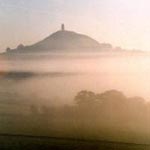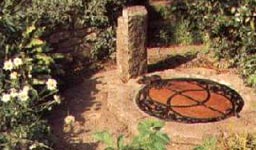Glastonbury

 Glastonbury is famous for being one of the most mystical sites in the world.
It has connections with King Arthur (the Arthurian legend), Joseph of Arimathea, Glastonbury Tor,
The Abbey, the Glastonbury Giants or Zodiac, the intersection of Ley Lines and Earth Energy Lines.
Glastonbury is also believed to be the mythical place known in Arthurian Lore as 'The Isle of Avalon'.
Glastonbury is famous for being one of the most mystical sites in the world.
It has connections with King Arthur (the Arthurian legend), Joseph of Arimathea, Glastonbury Tor,
The Abbey, the Glastonbury Giants or Zodiac, the intersection of Ley Lines and Earth Energy Lines.
Glastonbury is also believed to be the mythical place known in Arthurian Lore as 'The Isle of Avalon'.
In the Twin Peaks series Glastonbury/Glastonberry Grove is first seen at the end of episode 27.
Not until the final episode of the series, episode 29, was the place actually called by name,
Glastonbury/Glastonberry Grove by Agent Cooper. According to the original shooting scripts the spelling
was Glastonbury but later publications written by the same writers (Lynch, Frost and others) had a
different spelling, Glastonberry. The reason for the change was never given but it has been thought
that the change in spelling was provided as reference to the pies, the notable berry pies Norma Jennings
could bake at the Double-R Diner.
Regardless of the spelling, the reference to Glastonbury, England and the burial place of King Arthur
are not only just referenced but clearly given in the final episode of the series by both Agent Cooper and
Pete Martell. So why is Glastonbury, England referenced?
Relations for the Twin Peaks Mythos
- Glastonbury/Glastonberry Grove - the access to the Waiting Room and the lodges.
- Lodge spirits.
- The Log Lady, The Little Man From Another Place, the Giant, Agent Cooper, Annie, Windom Earle.
- Similiar story of either Cooper being trapped or of Earle bringing Annie into the lodges.
- Share multiple levels of symbolism and mystery.
- Others: black dogs, white horse, the Lady of the Lake (early script for the final episode).
Glastonbury Legends
Celtic Legends
- Glastonbury Tor is the Otherworld home of one of the Celtic Underworld Gods, Afallach.
- Ancient trail laced around the Tor leads to a gateway at the top of the hill.
- The hill of the Tor is hollow and is an entrance to the underworld itself.
- To honor their gods, some hills of Somerset are carved with white horses.
Arthurian Legends
- Glastonbury is believed to be the Isle of Avalon.
- Arthur's magical sword, Excalibur, was forged by an elf on the Isle of Avalon.
- Arthur rescued his abducted queen, Guenevere, from the clutches of the evil King Melwas
on Glastonbury Tor.
- On Arthur's orders, Bedwyr returned Excalibur to the Lady of the Lake from Pomparles Bridge.
- Arthur was brought to the Isle of Avalon for the healing of his mortal wound,
received in his final battle with Mordred at Slaughter Bridge in Cornwall.
- Arthur's and Guinevere's burial place was discovered in 1190 CE on the grounds
of Glastonbury Abbey.
- Arthur is sleeping under the hill at Cadbury Castle, awaiting the time for his return.
Christian Legends
- Glastonbury is the reputed birthplace of Christianity in England.
- A disciple of Jesus, Joseph of Arimathea landed by boat on Wearyall Hill bringing with him
the gospel and the Holy Grail.
- Joseph of Arimathea and his missionary party were granted Twelve Hides (about 120
acres) of land by the local pagan King Arviragus.
- On landing at Wearyall Hill, Joseph planted his staff into the ground and overnight it sprouted
into the famous Glastonbury Thorn.
- The Holy Grail was hidden by Joseph either in Chalice Well or within his grave.
Other Legends or Points of Interest
- Home to an ancient and powerful Goddess of transformation and rebirth, Brighde,
Goddess of healing, poetry and smithcraft.
- On the White Mare from the Seas, Brighde rides the Hollow Hills of Avalon.
- The Glastonbury Giants or Zodiac is a giant landscape configuration, a circle 10 miles
across. The 12 zodiac signs are formed by hills, outlined by roads and rivers.
- Popular retreat of the famous occultist, 'Dion Fortune' who spent the second
half of her life in a house near the base of the Tor which she believed to be
the place of the great 'Celtic Otherworld'.
- While in the area, Conan Doyle found inspiration for 'Hound of the
Baskervilles' based upon the legends of the Black Dogs of Dartmoor.
Locations
Glastonbury Tor

 This hill rises 522 feet above sea level, dominates the Glastonbury landscape, and
is visible for miles in the surrounding countryside. Before the marshes were drained, this hill
gave the appearance of an island and perhaps gave birth to the myth of the Isle of Avalon.
The hill is the oldest and most involved location on the site. Long before the construction
of the chapel that sits atop, the mound of Earth, a natural feature, was once a fortress with
a wooden wall surrounding the hill at the bottom. The mound has been carved with a trail that
winds around and up to the top. The trail is very old and is believed to have been first carved
by Druids for this ancient site of worship. Some investigators believe the trail was carved
by the Knights Templar as a marker for this site to link it with the Holy Grail. In the oldest
legends, Celtic, the hill is supposed to be hollow and walking the trail eventually ends at a
gateway at the top which leads to the spirit world. At some of the oldest surrounding graveyards
it was discovered that all the graves point directly to the hill. In Christian legends the
messiah is slated to reappear at this site.
Read more.
This hill rises 522 feet above sea level, dominates the Glastonbury landscape, and
is visible for miles in the surrounding countryside. Before the marshes were drained, this hill
gave the appearance of an island and perhaps gave birth to the myth of the Isle of Avalon.
The hill is the oldest and most involved location on the site. Long before the construction
of the chapel that sits atop, the mound of Earth, a natural feature, was once a fortress with
a wooden wall surrounding the hill at the bottom. The mound has been carved with a trail that
winds around and up to the top. The trail is very old and is believed to have been first carved
by Druids for this ancient site of worship. Some investigators believe the trail was carved
by the Knights Templar as a marker for this site to link it with the Holy Grail. In the oldest
legends, Celtic, the hill is supposed to be hollow and walking the trail eventually ends at a
gateway at the top which leads to the spirit world. At some of the oldest surrounding graveyards
it was discovered that all the graves point directly to the hill. In Christian legends the
messiah is slated to reappear at this site.
Read more.
Glastonbury Abbey

 Glastonbury Abbey is the oldest Christian foundation and once the most important abbey
in England. Only one steeple surrounded by green lawns and the outline of the old
abbey remain, but the sight is still stark and awe inspiring. Joseph of Arimanthea
supposedly built the first church on this site in 63CE. The supposed
resting place of King Arthur and Guinevere is on the Abbey grounds.
Read more.
Glastonbury Abbey is the oldest Christian foundation and once the most important abbey
in England. Only one steeple surrounded by green lawns and the outline of the old
abbey remain, but the sight is still stark and awe inspiring. Joseph of Arimanthea
supposedly built the first church on this site in 63CE. The supposed
resting place of King Arthur and Guinevere is on the Abbey grounds.
Read more.

Site of King Arthur's Grave
This sign at Glastonbury Abbey reads: "Site of King Arthur's Tomb. In the year
1191AD the bodies of King Arthur and his Queen were said to have been found on the south
side of the Lady Chapel. On April, 19th 1278AD, their remains were removed in the presence
of King Edward I and his Queen to a black marble tomb on this site. This tomb survived
until the dissolution of the Abbey in 1539AD.
The Chalice Well

 A spring once ran between the Tor and Chalice Hill in Glastonbury. What remains of the spring
is a well which is now surrounded by gardens. A description by Perlesvaus of Lancelot visiting
a spring near Avalon may refer to Chalice Well. Christian legend once held that the well ran
with Christ's blood; in actuality it is rust deposits from the source that gives the water its
red color. The well is said by some to be the place where the Holy Grail was secreted.
A spring once ran between the Tor and Chalice Hill in Glastonbury. What remains of the spring
is a well which is now surrounded by gardens. A description by Perlesvaus of Lancelot visiting
a spring near Avalon may refer to Chalice Well. Christian legend once held that the well ran
with Christ's blood; in actuality it is rust deposits from the source that gives the water its
red color. The well is said by some to be the place where the Holy Grail was secreted.
|




